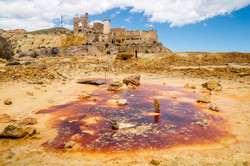Aluminium mobility and mine waste
Aluminium (Al) is one of the main elements found in waters affected by acid drainage from mines, in poorly-buffered lakes receiving acid rain and in the pore-water of acid sulphate soils. In these environments, Al plays a key role in mobilising other potentially polluting elements that can have a serious impact on ecosystems and even human health (for example Alzheimer’s disease). The risks posed by exposure to Al are controlled by the reactivity of Al-bearing minerals. Therefore, the RASMIN (Reactivity of aluminium sulphate minerals in mine wastes) project investigated the behaviour of the two main sulphate minerals controlling the mobility of aluminium. These were alunite (KA13(SO4)2(OH)6) and felsobanyaite (Al4(SO4(OH)10.4-5H2O). Project partners studied the minerals’ stability, how rapidly they dissolved and released Al to the environment and the importance of temperature in their dissolution and dissolution rate. They also explored what happens to the composition of solid alunite and felsobanyaite when they dissolved and how (on a molecular scale) dissolution takes place. To answer these questions, researchers conducted laboratory experiments that mimicked the dissolution of both minerals under the conditions most commonly found in natural systems. The evolution of both mineral and solution composition throughout the experiments were then determined using a range of techniques. The results were studied with the aid of two geochemical modelling and atomic computer simulations. The rates obtained for alunite and felsobanyaite were incorporated into mathematical expressions that enabled scientists to calculate their dissolution rates and the associated release of Al. These expressions were also used to assess Al behaviour under a wide range of pH and temperatures, which were typical of those found in most natural waters rich in sulphate. Results suggested that pH values around 4.5 and low temperatures would diminish alunite and felsobanyaite dissolution, favouring their preservation and decreasing the release of Al to the environment. These findings will provide a clearer understanding of the minerals’ environmental stability and the behaviour of Al during dissolution. RASMIN will help to bridge a key knowledge gap in understanding the factors controlling Al mobility in the environment and the risks posed by Al exposure. This will contribute to new mine development and to environmental and human health protection.







